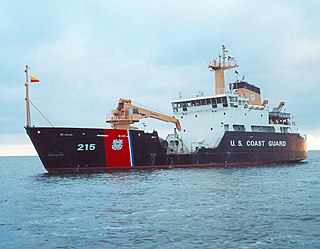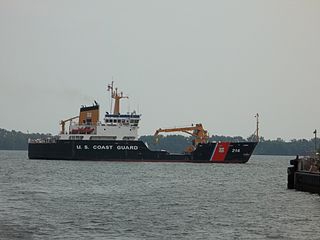
USCGC Sequoia (WLB-215) is a United States Coast Guard 225-foot Seagoing Buoy Tender, homeported in Apra Harbor, Naval Base, a deep-water port on the western side of the United States territory of Guam.

The USCG seagoing buoy tender is a type of United States Coast Guard Cutter used to service aids to navigation throughout the waters of the United States and wherever American shipping interests require. The U.S. Coast Guard has maintained a fleet of seagoing buoy tenders dating back to its origins in the U.S. Lighthouse Service (USLHS). These ships originally were designated with the hull classification symbol WAGL, but in 1965 the designation was changed to WLB, which is still used today.

USCGC Alder (WLB-216) is the final Juniper-class, 225-foot (69 m) seagoing buoy tender of the United States Coast Guard.

The Keeper class of coastal buoy tenders consists of fourteen ships built for and operated by the United States Coast Guard. The ships were launched between 1995 and 1999 and all remain in active service. Their primary mission is to maintain thousands of aids to navigation, both buoys and land-based. Their secondary missions include marine environmental protection, search and rescue, law enforcement, and light ice-breaking.

The USCGC Conifer was a 180 foot seagoing buoy tender. Conifer and her sister ships, commonly referred to as "one-eighties", served as the backbone of the Coast Guard's Aids to Navigation fleet for over 50 years before their replacement by the newer Juniper-class cutters.

USCGC Spar (WLB-206) is a United States Coast Guard Juniper-class seagoing buoy tender home-ported in Duluth, Minnesota. The ship maintains aids to navigation in the Twin Ports and Great Lakes.

USCGC Maple (WLB-207) is a Juniper-class seagoing buoy tender operated by the United States Coast Guard. She was based at Sitka, Alaska for 16 years and is currently homeported at Atlantic Beach, North Carolina. Her primary mission is maintaining aids to navigation, but she also supports search and rescue, law enforcement, oil spill response, and other Coast Guard missions.

United States Coast Guard Cutter is the term used by the U.S. Coast Guard for its commissioned vessels. They are 65 feet (19.8 m) or greater in length and have a permanently assigned crew with accommodations aboard. They carry the ship prefix USCGC.

The U.S. Coast Guard Cutter Oak is a United States Coast Guard seagoing buoy tender; the second of her name and the eleventh of the Juniper class. Home ported in Newport, Rhode Island the "Maine Responder" maintains Aids to Navigation (ATON) along the rugged New England coastline, promoting economic security through navigation safety of the Marine Transportation System. A multi-mission platform, the cutter can also support search & rescue, domestic icebreaking, living marine resources maritime law enforcement, environmental protection, national defense and homeland security missions. The cutter occasionally assists with maintenance support of the National Oceanic and Atmospheric Administration (NOAA) National Data Buoy Center's offshore weather buoys.

USCGC Fir (WLB-213) is a Juniper-class cutter of the United States Coast Guard. USCGC Fir is under the Operational Control (OPCON) of the Commander of the Thirteenth Coast Guard District and is homeported in Astoria, Oregon. Fir's primary area of responsibility is the coastal waters, river bars and high seas of the Washingtonian and Oregonian coasts. USCGC Fir conducts heavy lift aids to navigation operations, law enforcement and other missions as directed.

USCGC Elm (WLB-204) is a U.S. Coast Guard Juniper-class seagoing buoy tender home-ported in Astoria, Oregon. She is responsible for maintaining aids to navigation on the coasts of Oregon and Washington, including the Columbia River.

USCGC Woodrush (WLB-407) was a buoy tender that performed general aids-to-navigation (ATON), search and rescue (SAR), and icebreaking duties for the United States Coast Guard (USCG) from 1944 to 2001 from home ports of Duluth, Minnesota and Sitka, Alaska. She responded from Duluth at full speed through a gale and high seas to the scene of the SS Edmund Fitzgerald sinking in 1975. In 1980, she took part in a rescue rated in the top 10 USCG rescues when she helped to save the passengers and crew of the cruise ship Prinsendam after it caught fire in position 57°38"N 140° 25"W then while being towed sank off Graham Island, British Columbia. She was one of the first vessels to respond to the Exxon Valdez oil spill in 1989. She was decommissioned on 2 March 2001 and sold to the Republic of Ghana to serve in the Ghana Navy.

USCGC Sycamore (WLB-209) is a United States Coast Guard seagoing buoy tender, the second of her name and the ninth of the Juniper-class. She is now home-ported in Newport, Rhode Island, following a one year long Midlife Maintenance Availability (MMA) in Baltimore, Maryland. She was originally home-ported in Cordova, Alaska. Sycamore primarily tends to aids-to-navigation (ATON) in Martha's Vineyard, the Long Island Sound, Hudson River, and New York City Harbor and entrances; however she is also responsible for maintenance support of National Data Buoy Center's offshore weather buoys. In addition to her primary ATON role, Sycamore also performs other duties, such as, marine environmental protection, maritime law enforcement, domestic icebreaking, search and rescue, and homeland security missions.
USCGC Tupelo WAGL/WLB-303, was a Cactus (A) Class 180-foot buoy tender vessel built by Zenith Dredge Company of Duluth, Minnesota. Her keel was laid 15 August 1942, launched 28 November 1942 and commissioned on 30 August 1943. She was built as a WAGL and redesignated a WLB in 1965.

USCGC Hollyhock (WLB-214) is a 225-foot (69 m) Juniper-class cutter of the United States Coast Guard.

USCGC Cypress (WLB-210) is a United States Coast Guard cutter and the tenth Juniper-class seagoing buoy tender. She is outfitted with advanced technological and navigational capabilities that allow her to be positioned correctly for exact placement of buoys through the use of controllable-pitch propellers and stern and bow thrusters.

The USCGC Willow (WLB-202) is a United States Coast Guard seagoing buoy tender, the third of her name and the second of the Juniper-class. She is home-ported in Charleston, South Carolina, where she replaced her sister ship USCGC Oak in servicing 257 aids to navigation in District 7. Willow's area of operations stretches from South Carolina down to Caribbean, including Puerto Rico, Cuba, U.S. Virgin Islands and Haiti. In addition to her primary aids-to-navigation (ATON) role, Willow also performs other duties, such as maritime border security, marine environmental protection, maritime law enforcement, and search and rescue. The Willow transitioned from her former home port of Newport, RI in 2017 after spending over a year in a Baltimore dry dock being refitted and modernized.

USCGC Aspen (WLB-208) is the eighth cutter in the Juniper-class 225 ft (69 m) of seagoing buoy tenders. She is under the operational control of the Commander of the Eleventh U.S. Coast Guard District and is home-ported at Yerba Buena Island in San Francisco, California. Her primary area of responsibility is the coastal waters, river bars and high seas from the California–Oregon border to San Diego, California. Aspen conducts heavy lift aids-to-navigation operations, and law enforcement, homeland security, environmental pollution response, and search and rescue as directed.

USCGC Kukui (WLB-203) is the third cutter in the Juniper-class 225 ft (69 m) of seagoing buoy tenders and is the third ship to bear the name. She is under the operational control of the Commander of the Seventeenth Coast Guard District and is home-ported in Sitka, Alaska. Her primary area of responsibility is the inland and coastal waters of southeastern Alaska. Kukui conducts heavy lift aids-to-navigation operations, and law enforcement, homeland security, environmental pollution response, and search and rescue as directed.

USCGC Walnut (WLB-205) is the fifth cutter in the Juniper-class 225 ft (69 m) of seagoing buoy tenders and is the second ship to bear the name. She is under the operational control of the Commander of the Fourteenth Coast Guard District and is home-ported on Sand Island in Honolulu, Hawaii. Her primary area of responsibility is the coastal waters and high seas around the Hawaiian Islands and American Samoa. Walnut conducts heavy lift aids-to-navigation operations, and law enforcement, homeland security, environmental pollution response, and search and rescue as directed.




















